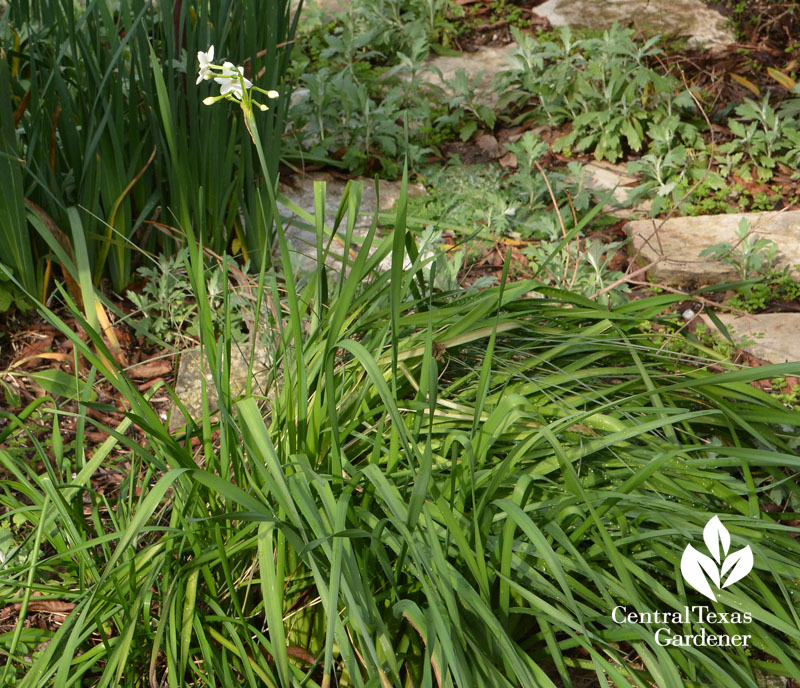January 19, 2017
Front Yard Food Forest & Pruning Prep!
Yep, we’ve gotten a little spoiled over here in Central Texas with recent mild winters. Then, coldest temps since 2011 blasted us out of smug complacency. Despite unexpected brown around my garden, this narcissus cheerfully rises above the flattened.

Only time will tell if my firecracker ferns return from the roots.

Many people lose native Barbados cherry, but I never have. I’ll cut it back in late February. It needed pruning anyway! Beyond, bay laurel covers for its temporary disgrace.

I deliberately planted spuria irises in this spot that hosts native plants that go brown to the ground every year (but return). Mushy crinums are routine, though they’re putting out new growth thanks to the warm days (not good!). Daunted daylilies just need a trim and some dividing!

Agave celsii got a little nipped as did nearby Iris ‘Nada.’ I’ll cut back the iris later and leave the agave alone.

Daphne’s Plant of the Week, silvery Yucca pallida, is hardy to -10.

It works just fine on my clay soil (albeit amended over the years) to tantalize me with its ever growing bloom stalk in late spring.

I love this yucca for its silvery tones, even in part shade to dappled sunlight. In this garden at BELO at UT, it needs little maintenance and certainly very little water (though they handle rain bombs just fine).

Another thing I love: Yucca pallida doesn’t form a stalk and colonizes to maximize your buy. Find out more.

Since pruning is definitely on our priority list, this week Julie Clark from Stronger Than Dirt, an all-women maintenance team, puts us on the right track.

First, don’t start just yet unless something’s driving you nuts. Certainly, we can cut Turk’s cap stems to the ground. And I’ll cut my Hamelia patens to just above the ground soon, since it won’t pop new growth until the soil warms up.

But with our radical swings from cold to heat, February’s a better bet to get busy. Get Julie’s tips on evergreens, perennials, roses and grasses.

John shows off some mighty fine tools to make the job easier. Using pruners that are too small can twist and damage bark, rather than leaving a nice clean cut.

I’m a Felco fan for my hand pruners, since it’s easy to replace parts that wear out.

Sadly, Kathy Bartsch will ultimately need some folks with chainsaws to handle her cedar (Ashe juniper) trees.

For several months, she’s noticed a yellowish growth that’s a tough, rubbery consistency. Daphne diagnoses this as a fungus that’s now feeding on the interior of the tree. Find out more.

On tour, when Ben McConnell and Steph Hengle turned their front yard into food, the neighbors stopped by for dinner!


In their (former) Bouldin Creek neighborhood, Ben dug out truckloads of rocks to create berms, enriched frequently with compost, vermiculture castings, and lots of underground earthworms.


An essential part of his permaculture philosophy was directing flooding rainwater on their sloping lot with berms and swales that follow the yard’s contours. “That’s one reason for the berms, is to be able to capture and store that water and all the swales that are behind the berms to slow down that water,” Ben noted.


Two cisterns collect rainwater.

Even in a small front yard food forest, they’ve got room for 18 different fruit trees, along with two pecans. They’re even growing grapevines on their front porch trellis.

Since nothing goes to waste here, when Ben dismantled a wooden patio structure, he turned it into raised beds, benches, and compost bins.

To allow their dogs (and now ducks) front yard access, Ben built an open slat fence and entrance gate arbor. Its design lets neighbors engage, but keeps Ben and Steph’s pups from strolling the ‘hood.


Then they expanded the family with gregarious Indian Runner ducks, raised inside when tiny ducklings.

Ben built onto their patio stone frame to make a raccoon-proof home for them.

After Trudie and Mr. and Mrs. Quackenbush frolic in their pool, Ben nourishes the garden with its fertilizer-enriched water.

Although they shared harvests with neighbors, many asked if they could buy more. So, for a few years, Ben and Steph held a popular Saturday morning farm stand where everyone swapped recipes, planting tips, and neighborly chat.

In November 2016, Ben and Steph held their last farm stand. Breaking ground once again on a 150 acre spread near Temple, they’ll be able to supply even more local food to tasteful restaurants.

Follow their latest adventure @bouldinfoodforest.
And many thanks to Freejay McCloud for the music!
Watch the whole story now.
And many thanks for stopping by! See you next week, Linda

